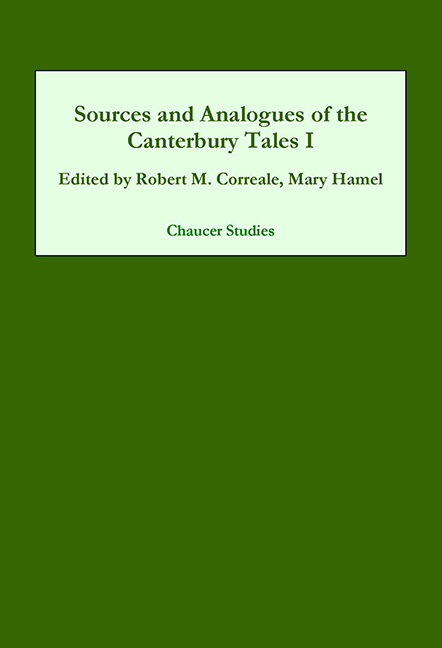Book contents
- Frontmatter
- Contents
- preface
- Acknowledgements
- The Frame
- The Reeve's Tale
- The Cook's Tale
- The Friar's Tale
- The Clerk's Tale
- The Squire's Tale
- The Franklin's Tale
- The Pardoner's Prologue and Tale
- The Tale of Melibee
- The Monk's Tale
- The Nun's Priest's Tale
- The Second Nun's Prologue and Tale
- The Parson's Tale
- Contributors and editors
- General Index
- Index of Manuscripts
The Franklin's Tale
Published online by Cambridge University Press: 25 October 2017
- Frontmatter
- Contents
- preface
- Acknowledgements
- The Frame
- The Reeve's Tale
- The Cook's Tale
- The Friar's Tale
- The Clerk's Tale
- The Squire's Tale
- The Franklin's Tale
- The Pardoner's Prologue and Tale
- The Tale of Melibee
- The Monk's Tale
- The Nun's Priest's Tale
- The Second Nun's Prologue and Tale
- The Parson's Tale
- Contributors and editors
- General Index
- Index of Manuscripts
Summary
The Franklin's Tale incorporates several kinds of literary sources in a story centering on the folklore motif of the “rash promise.” Nineteenth- and early-twentieth-century scholars traces the roots of the story to Oriental precursors. Medieval versions of the story appear in Jean de Condé's Chevalier à la manche and Don Juan Manuel's Conde Lucanor as well as in Matteo Boiardo's Orlando innamorato. Chaucer's sources for the Franklin's Tale divide into three groups. His major narrative source is a story that Boccaccio included in a sequence of “Questioni d'amore” (Love Questions) in the Filocolo and then retold in shortened form and with new thematic emphases in the Decameron. Menedon's story in the Love Questions of Book 4 of the Filocolo is closest to the Franklin's Tale in narrative elements and details, although some scholars have argued recently for the thematic influence of Emilia's tale from Decameron 10.5. A second group of sources furnishes topical references and materials used for thematic elaboration in the tale. The third group comprises echoes and reminiscences of various Latin and vernacular works. This chapter focuses on the first two kinds of sources, leaving aside verbal echoes and parallels in phrasing.
The question of Chaucer's major source is complicated historically by the Franklin's announced intention to retell a Breton lay that he has “in remembraunce” (V.709–15). Relying on the prologue, scholars from the late eighteenth century onward assumed that Chaucer must have worked from the text of a lay, yet no extant lay in French or English corresponds to the details of Chaucer's poem. Thirty-four lays survive in French, beginning with Marie de France's twelfth-century collection, which defined many, though not all, characteristics of the genre. Eight English lays besides the Franklin's Tale survive. They divide into two groups formally and chronologically. Four lays written in couplets, including the lays of the Auchinleck MS, date from the first half of the fourteenth century; four tail-rhyme lays date from the second half. The thematic resemblances to the French lays and their English imitations led scholars like W. H. Schofield to propose that Chaucer worked from a poem now lost. Laura Hibbard Loomis suggested, however, that Chaucer's knowledge of the genre came largely from the Auchinleck MS.
- Type
- Chapter
- Information
- Sources and Analogues of the Canterbury Tales: vol. I , pp. 211 - 266Publisher: Boydell & BrewerPrint publication year: 2002

